Development and Evaluation of a WRF-Based Mesoscale Numerical Weather Prediction System in Northwestern China
Abstract
1. Introduction
2. Model System Design
3. The Effects of Vegetation Coverage Data on Prediction
3.1. Description of Vegetation Coverage Data
3.2. Experimental Design
3.3. Temperature Prediction Validation
3.4. Wind Speed Prediction Validation
4. The Effect of Model Vertical Resolution on Precipitation Prediction
4.1. Experimental Design
4.2. Analysis of Results
4.2.1. Land Surface Elements
4.2.2. High-Altitude Elements
5. The Assimilation of Conventional Data and Its Impact on Precipitation
5.1. The Design of Data Assimilation Schemes
5.2. Comparison of Assimilation Experiment Results
6. Model Prediction Validation
6.1. Assessment of the Overall Model Prediction Ability
6.1.1. Surface Elements
6.1.2. High-Altitude Elements
6.1.3. Precipitation
6.2. Statistics of the Year-Round Evaluation
6.2.1. Surface Variables
6.2.2. High-Altitude Elements
6.2.3. Twenty-Four Hour Precipitation
7. Conclusions and Discussion
- Adding a data assimilation process can significantly enhance and improve the prediction ability and performance of the system. The results suggest that assimilating ground or air sounding data to the system can significantly improve the forecast skills although assimilating both data has the largest improvement. If different forecast periods are compared, data assimilation has most significant improvement for its 6–9 h forecast product.
- Analysis of surface fields shows that the simulated spatial distributions/patterns are closer to the observations when the sensitivity with 55 vertical layers and control experiment with 40 vertical layers are compared. The sensitivity experiment has smaller averaged errors for 48 h predicted 2 m air temperature, absolute humidity, and relative humidity when compared to the control experiment, in particular at the initial time. As forecast time increases, the difference between sensitivity and control experiment decreases.
- Comparisons of the 24 h predictions of high-altitude elements show that the full wind speed prediction with 55 layers is greater than that with 40 layers. The scores of the 24 h precipitation prediction show that the TS and ETS of different precipitation levels with 55 layers are all higher than those with 40 layers. Additionally, the higher the precipitation level is, the better the advantage of the 55 layer model.
- Updating the vegetation coverage data in the WRF model can accurately reflect the actual conditions in some areas and improve prediction results. The updated land-use data can reduce error in all three model domains.
Author Contributions
Funding
Acknowledgments
Conflicts of Interest
References
- Kang, E.; Cheng, G.; Dong, Z. Glacier-Snow Water Resources and Mountain Runoff in the Arid Area of Northwest China; Science Press: Beijing, China, 2002. [Google Scholar]
- Anxiang, D.; Huzhi, B.; Xiaobin, L. New development of arid climate research in northwest China from 2001 to 2005 and main scientific problems. Arid Meteorol. 2006, 24, 57–62. [Google Scholar]
- Barker, D.; Huang, X.-Y.; Liu, Z.; Auligné, T.; Zhang, X.; Rugg, S.; Ajjaji, R.; Bourgeois, A.; Bray, J.; Chen, Y. The weather research and forecasting model’s community variational/ensemble data assimilation system: Wrfda. Bull. Am. Meteorol. Soc. 2012, 93, 831–843. [Google Scholar] [CrossRef]
- Zhang, Q.; Zhao, Y.; Zhang, C.; Li, Y.; Sun, G.; Gao, Q. Issues about hydrological cycle and water resource in arid region of northwest China. Arid Meteorol. 2008, 2, 001. [Google Scholar]
- Chen, W.; Wang, Q. The principal and application of the mesoscale operational numerical forecasting experiment model system: Part 2 model physical process. Gansu Meteorol. 1995, 2, 6–12. [Google Scholar]
- Chen, W.; Liu, X.; Li, R.; Wang, Q.; Shen, B. The principal and application of the mesoscale operational numerical forecasting experiment model system: Part 1 system introduction, equations and numerical treatment of the model. Gansu Meteorol. 1995, 1, 9–15. [Google Scholar]
- Zhang, T.; Wang, S.; Wang, X.; Cheng, P.; He, X. The operational system of Lanzhou limited area mesoscale numerical prediction model and its application. Arid Meteorol. 2005, 3, 79–84. [Google Scholar]
- Duan, H.-X.; Zhao, J.-H.; Li, Y.-H.; Huo, W. A verification on the prediction efficiency of grapes-sdm dust-storm model used in recent years. J. Desert Res. 2013, 1, 29. [Google Scholar]
- Li, Y.; Zhao, J.; Xue, J.; Chen, D.; Shen, X.; Wang, H.; Chen, Y. Study on sand-dust numerical forecasting model coupled with grapes and its application in northwest China. Adv. Earth Sci. 2005, 20, 999–1011. [Google Scholar]
- Zhang, Q.; Zhang, C.; Bai, H.; LI, L.; Sun, L.; Liu, D.; Wang, J.; Zhao, H. New development of climate change in northwest China and its impact on arid environment. J. Arid Meteorol. 2010, 1, 001. [Google Scholar]
- Lin, M.-L.; Chen, C.-W.; Wang, Q.-B.; Cao, Y.; Shih, J.-Y.; Lee, Y.-T.; Chen, C.-Y.; Wang, S. Fuzzy model-based assessment and monitoring of desertification using modis satellite imagery. Eng. Comput. 2009, 26, 745–760. [Google Scholar] [CrossRef]
- Chen, J.; Xue, D. An overview on recent progresses of the operational numerical weather prediction models. Acta Meteorol. Sin. 2004, 5, 009. [Google Scholar]
- Done, J.; Davis, C.A.; Weisman, M. The next generation of nwp: Explicit forecasts of convection using the weather research and forecasting (WRF) model. Atmos. Sci. Lett. 2004, 5, 110–117. [Google Scholar] [CrossRef]
- Yan, H.; Qian, Y.; Lin, G.; Leung, L.; Yang, B.; Fu, Q. Parametric sensitivity and calibration for the kain-fritsch convective parameterization scheme in the WRF model. Clim. Res. 2014, 59, 135–147. [Google Scholar] [CrossRef][Green Version]
- Chou, S.-H. An example of vertical resolution impact on WRF-VAR analysis. Electron. J. Oper. Meteorol 2011, 12, 1–20. [Google Scholar]
- Wang, X.P.; Li, X.R.; Xiao, H.L.; Berndtsson, R.; Pan, Y.X. Effects of surface characteristics on infiltration patterns in an arid shrub desert. Hydrol. Process. Int. J. 2007, 21, 72–79. [Google Scholar] [CrossRef]
- Kumar, A.; Chen, F.; Barlage, M.; Ek, M.B.; Niyogi, D. Assessing impacts of integrating modis vegetation data in the weather research and forecasting (WRF) model coupled to two different canopy-resistance approaches. J. Appl. Meteorol. Climatol. 2014, 53, 1362–1380. [Google Scholar] [CrossRef]
- Wen, X.; Lu, S.; Jin, J. Integrating remote sensing data with WRF for improved simulations of oasis effects on local weather processes over an arid region in northwestern China. J. Hydrometeorol. 2012, 13, 573–587. [Google Scholar] [CrossRef]
- Yang, J.; Duan, K.; Wu, J.; Qin, X.; Shi, P.; Liu, H.; Xie, X.; Zhang, X.; Sun, J. Effect of data assimilation using WRF-3dvar for heavy rain prediction on the northeastern edge of the tibetan plateau. Adv. Meteorol. 2015. [Google Scholar] [CrossRef]
- Siuta, D.; West, G.; Stull, R. WRF hub-height wind forecast sensitivity to pbl scheme, grid length, and initial condition choice in complex terrain. Weather Forecast 2017, 32, 493–509. [Google Scholar] [CrossRef]
- Thompson, G.; Tewari, M.; Ikeda, K.; Tessendorf, S.; Weeks, C.; Otkin, J.; Kong, F. Explicitly-coupled cloud physics and radiation parameterizations and subsequent evaluation in WRF high-resolution convective forecasts. Atmos. Res. 2016, 168, 92–104. [Google Scholar] [CrossRef]
- Yang, B.; Zhang, Y.; Qian, Y.; Huang, A.; Yan, H. Calibration of a convective parameterization scheme in the WRF model and its impact on the simulation of east asian summer monsoon precipitation. Clim. Dyn. 2015, 44, 1661–1684. [Google Scholar] [CrossRef]
- Ran, Y.-h.; Li, X.; Lu, L. Accuracy evaluation of the four remote sensing based land cover products over China. J. Glaciol. Geocryol. 2009, 3, 011. [Google Scholar]
- Parrish, D.F.; Derber, J.C. The national meteorological center’s spectral statistical-interpolation analysis system. Mon. Weather Rev. 1992, 120, 1747–1763. [Google Scholar] [CrossRef]
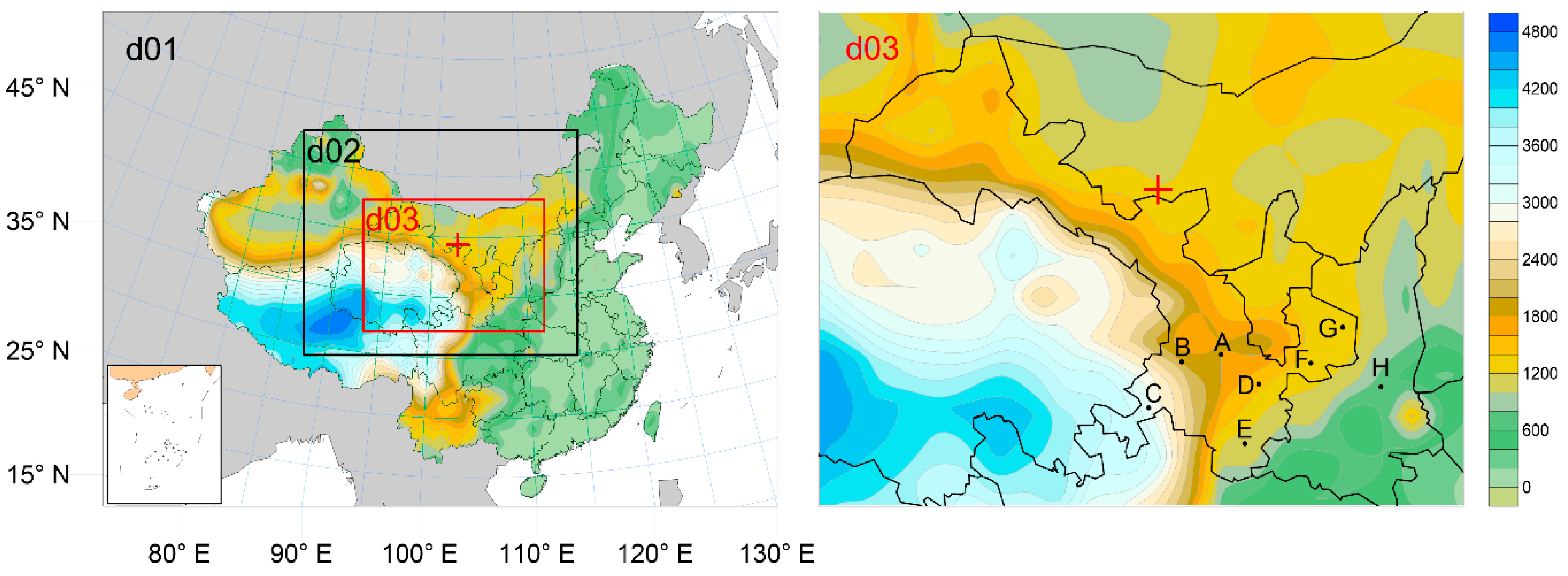
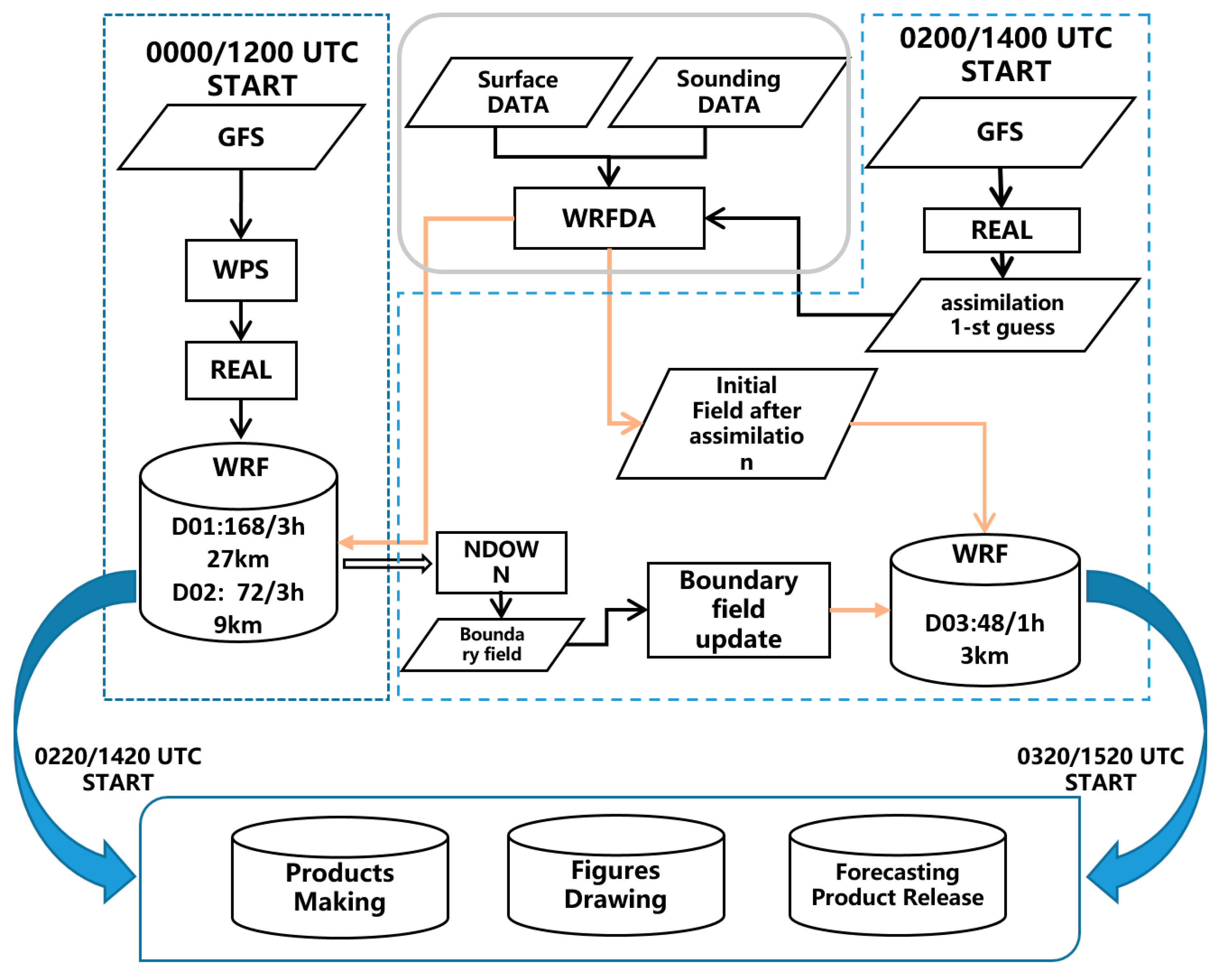
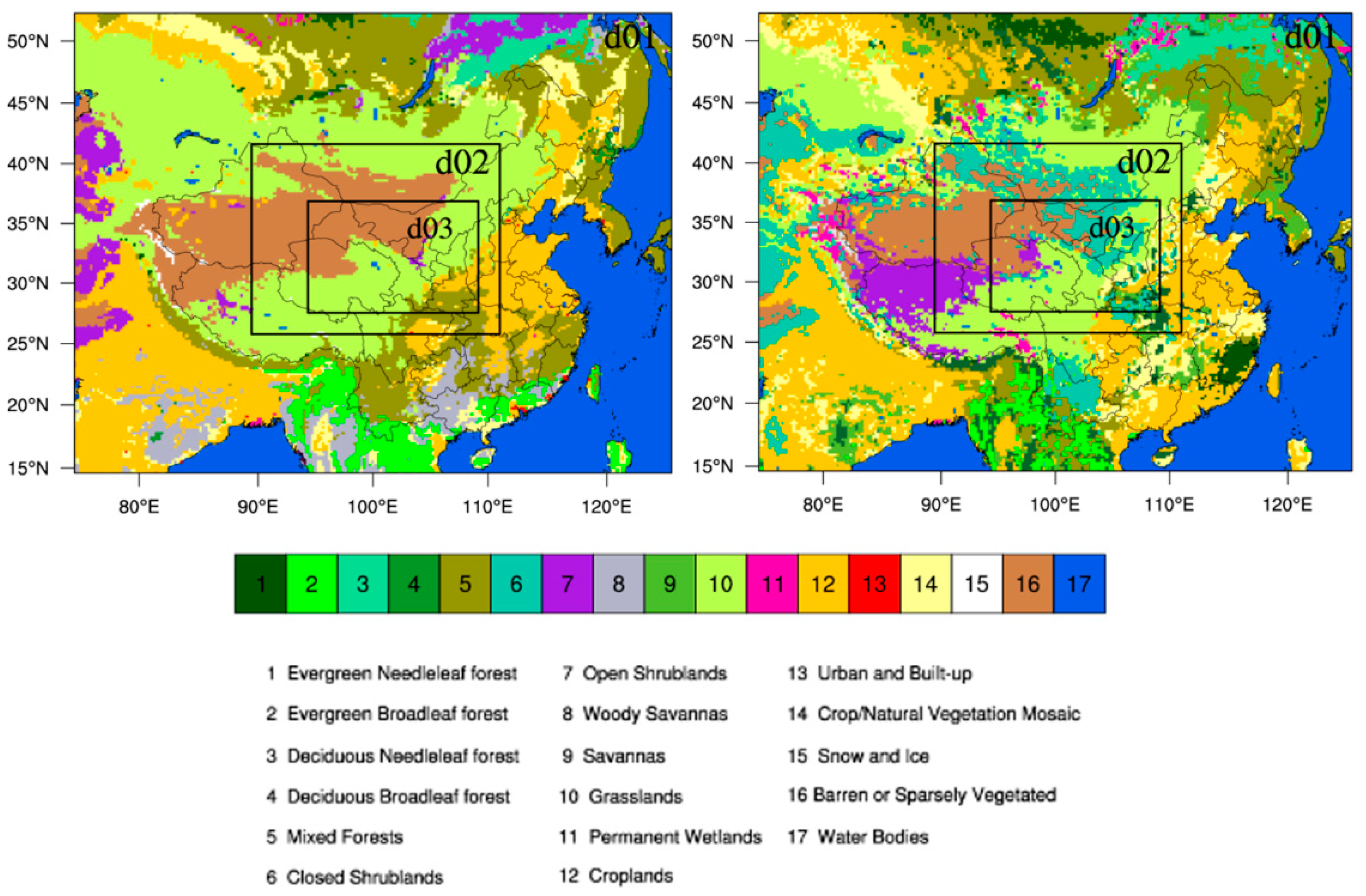
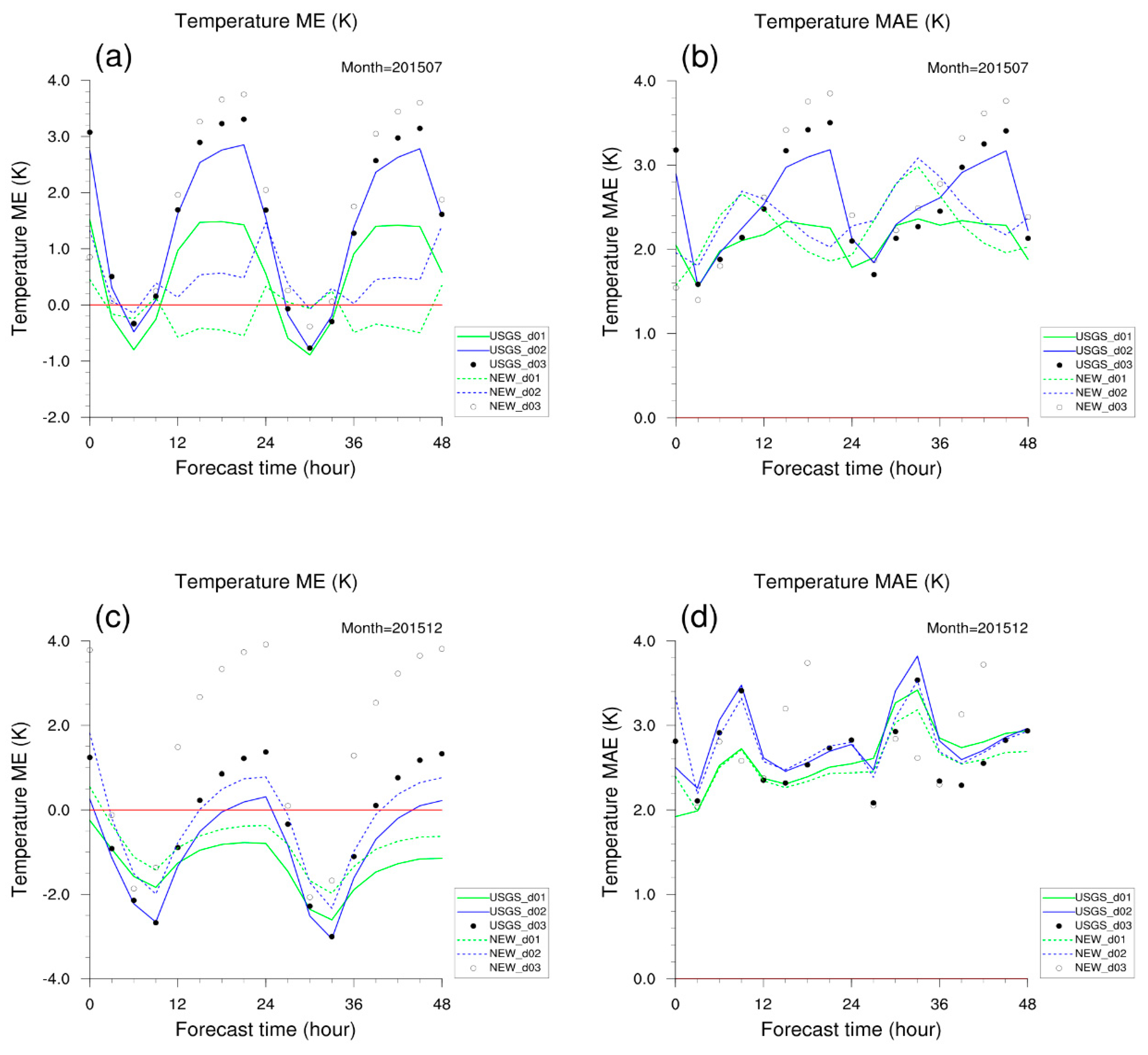
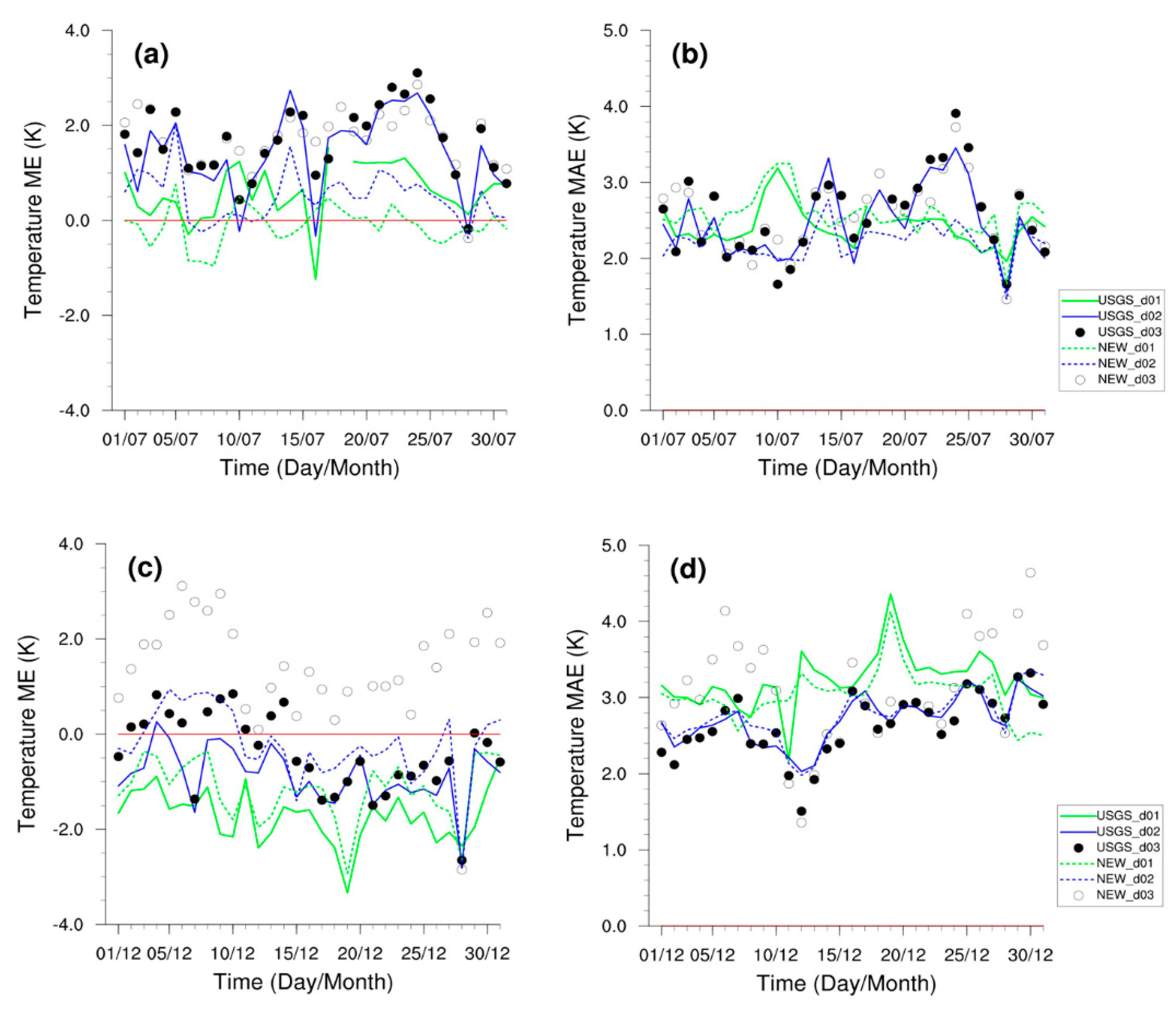
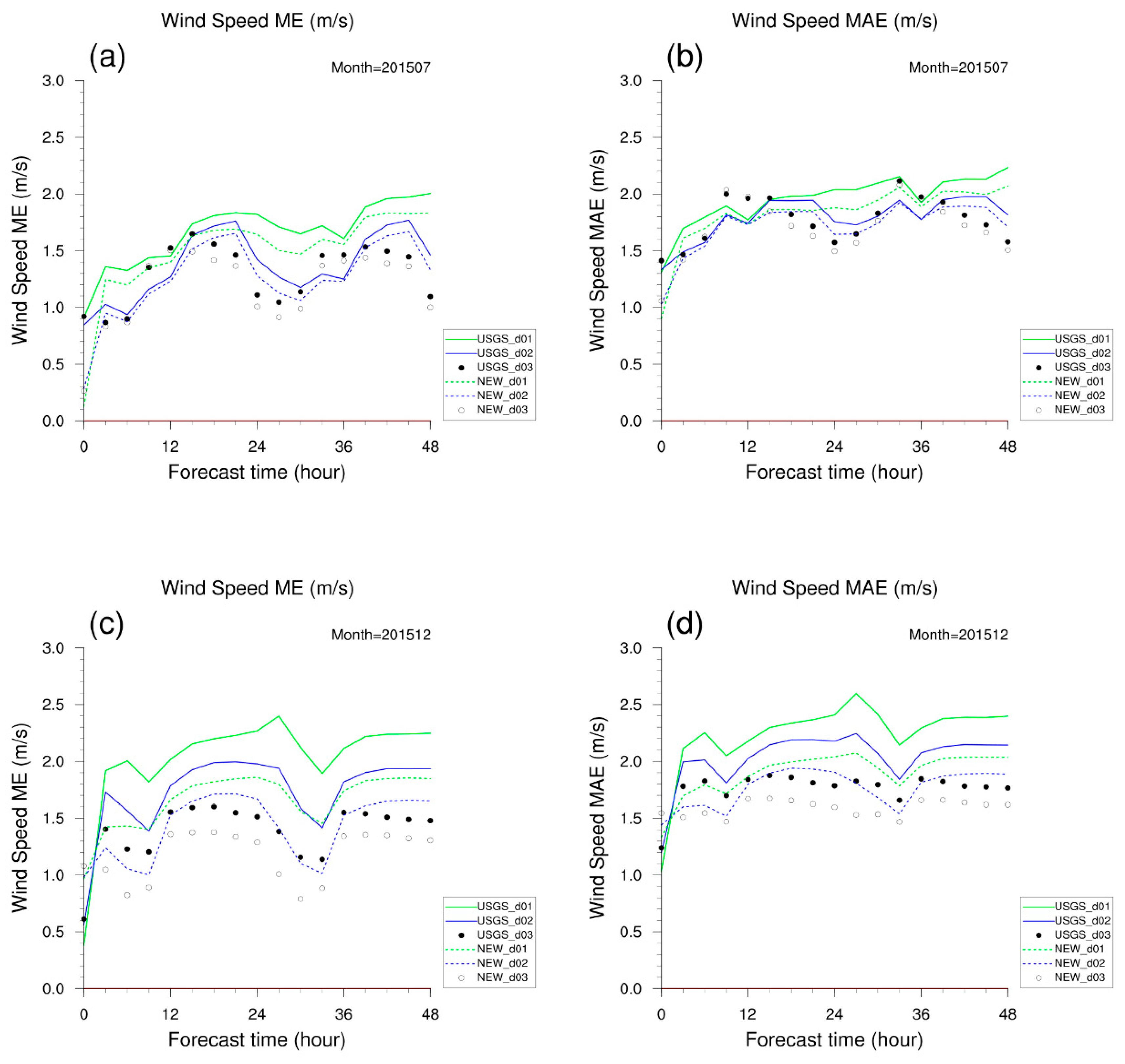
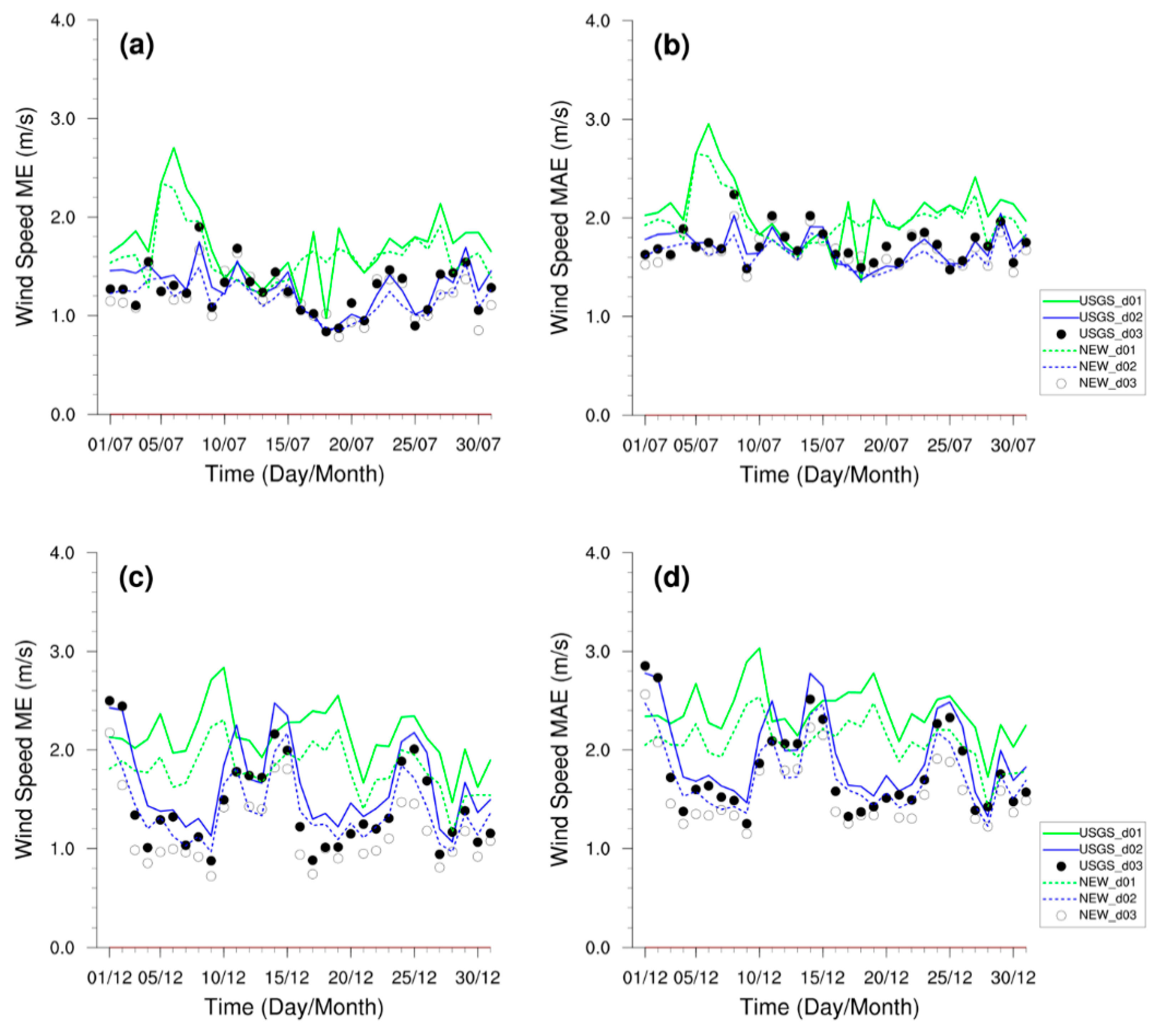

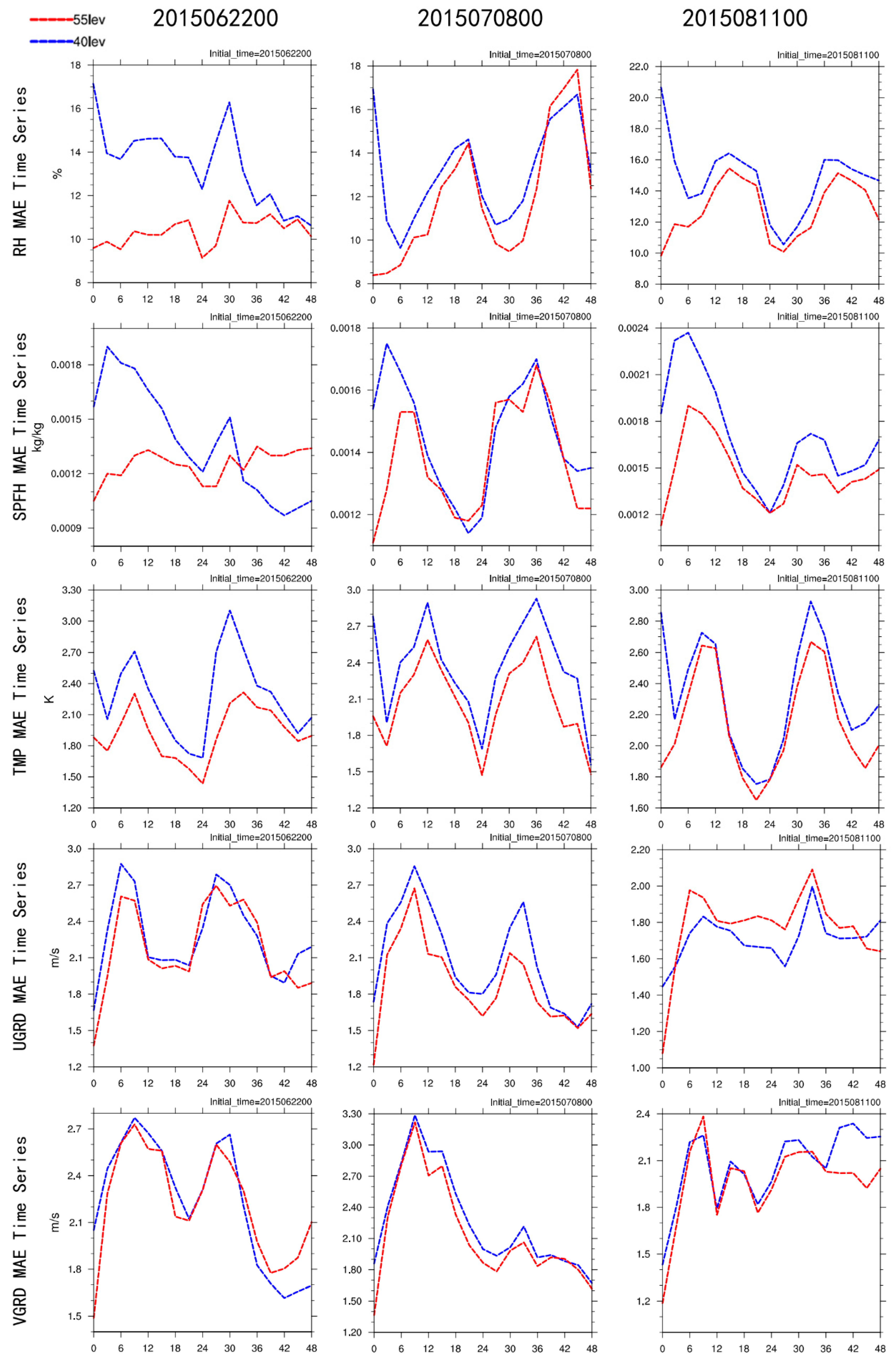
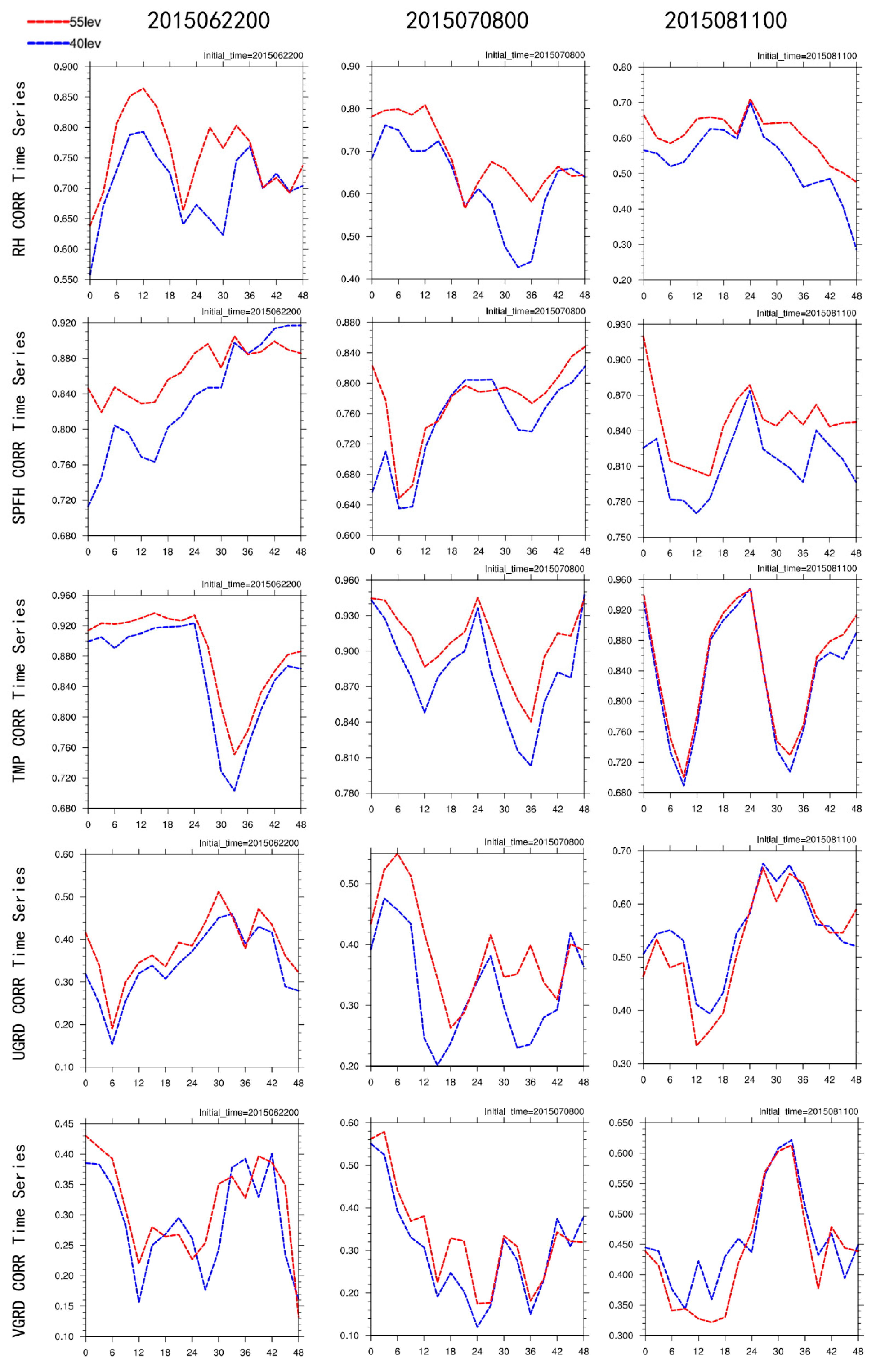
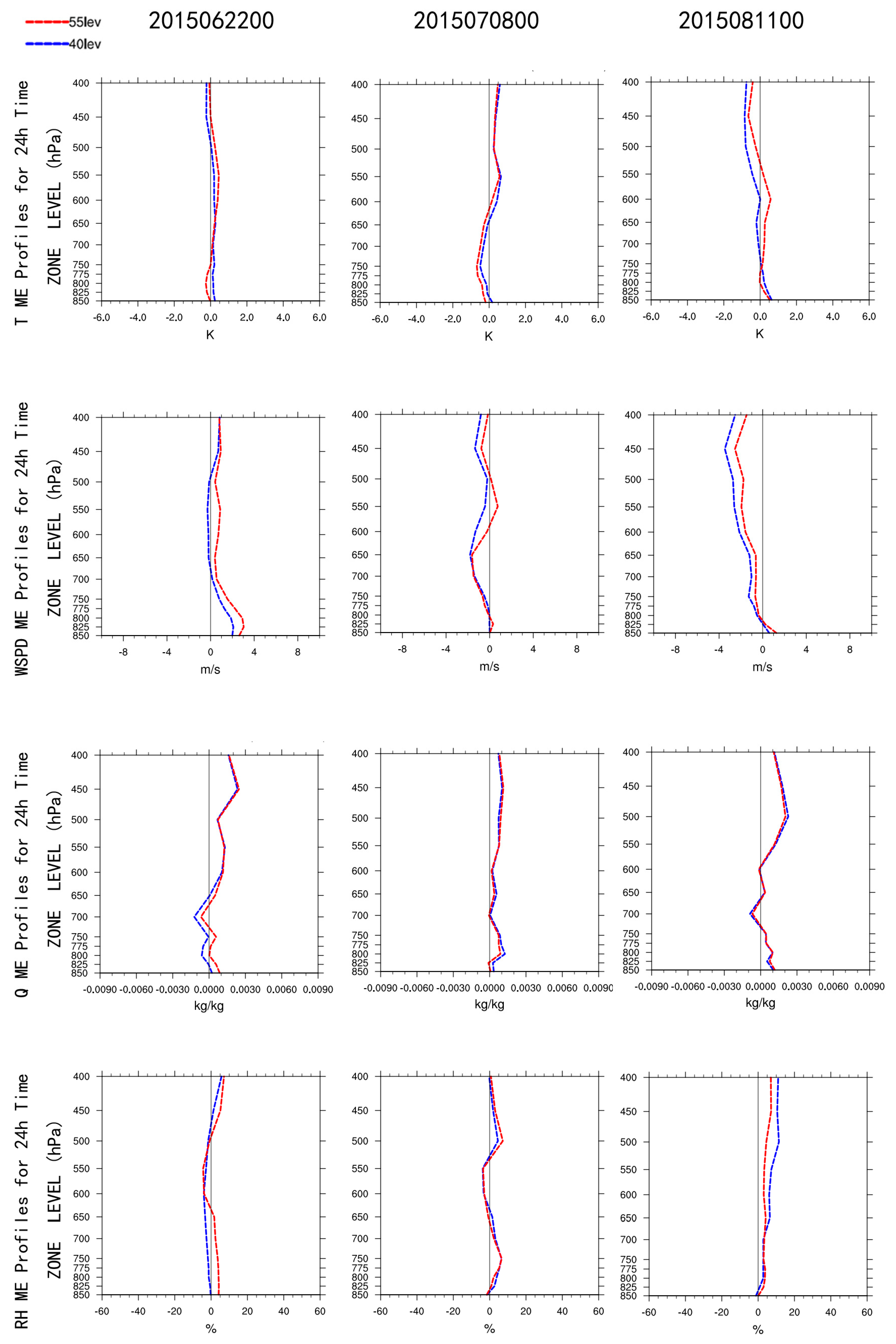
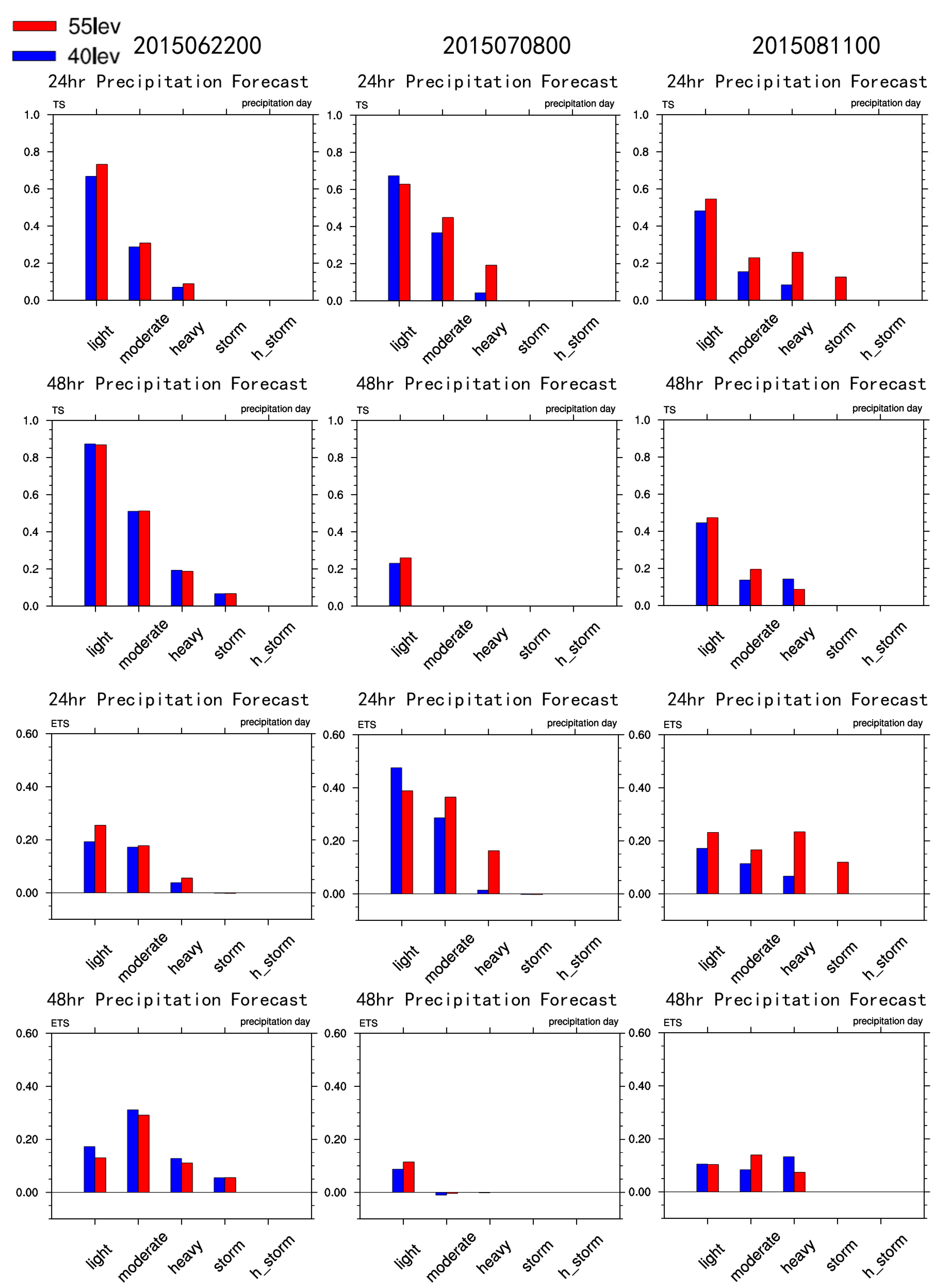

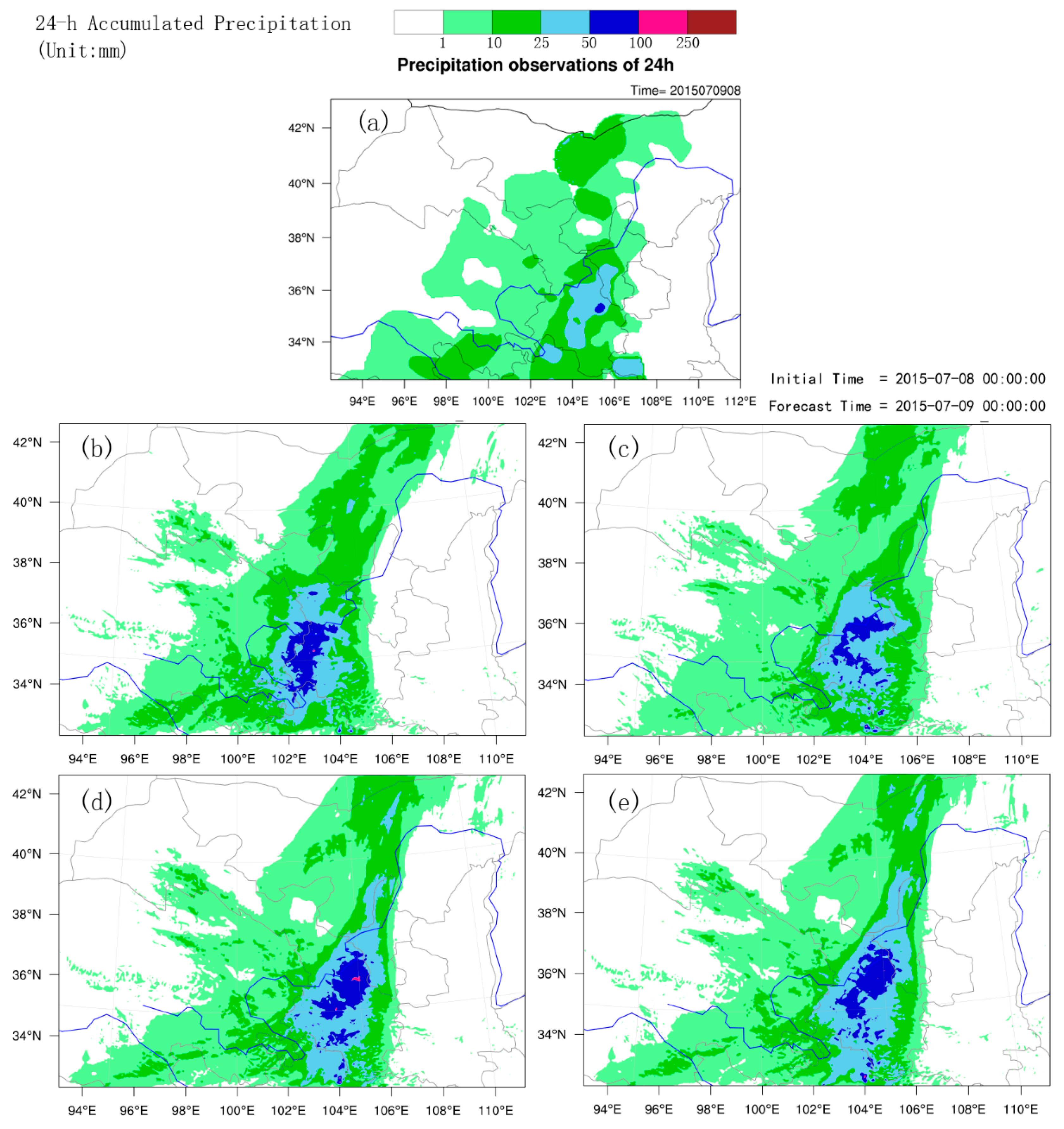
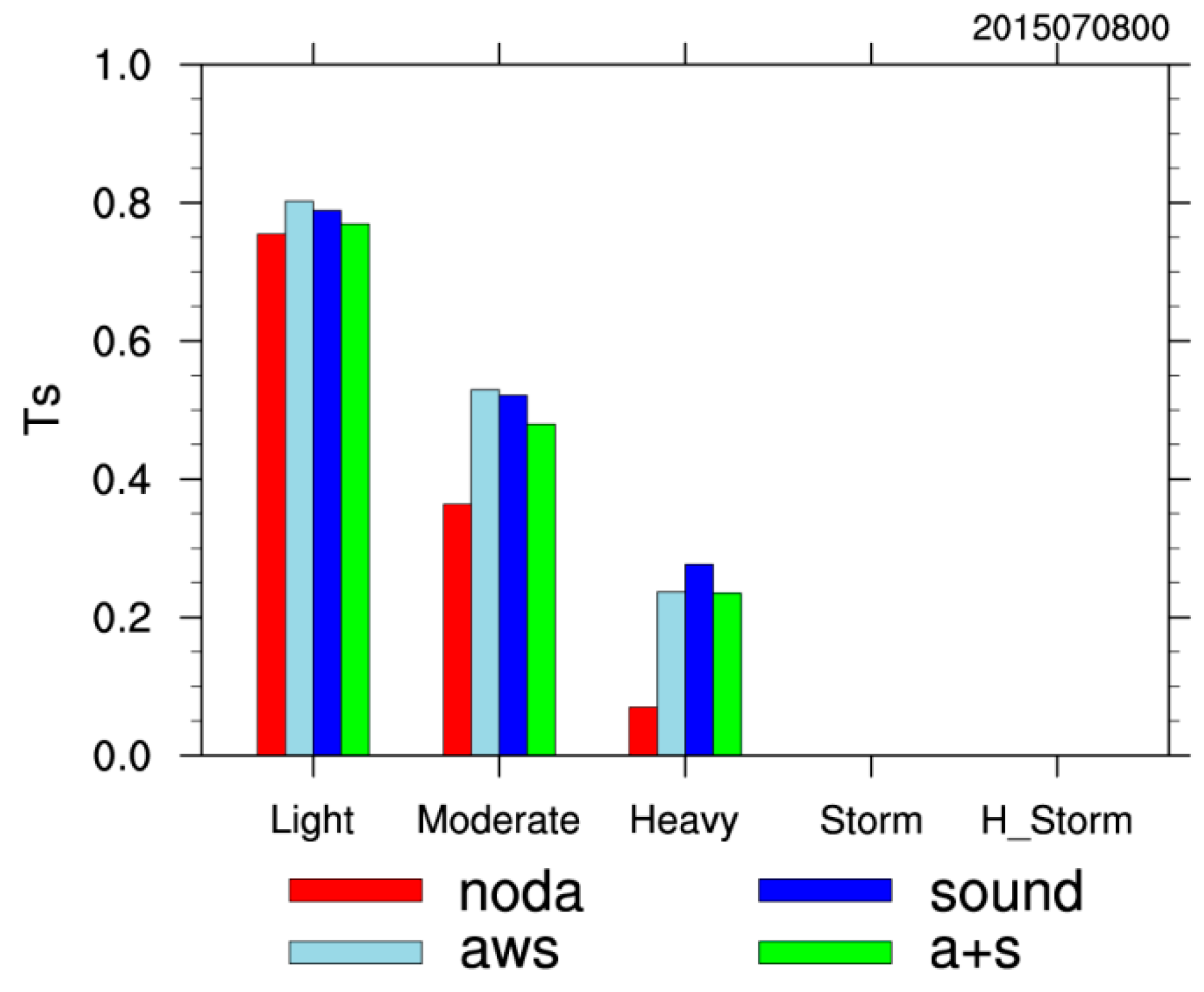
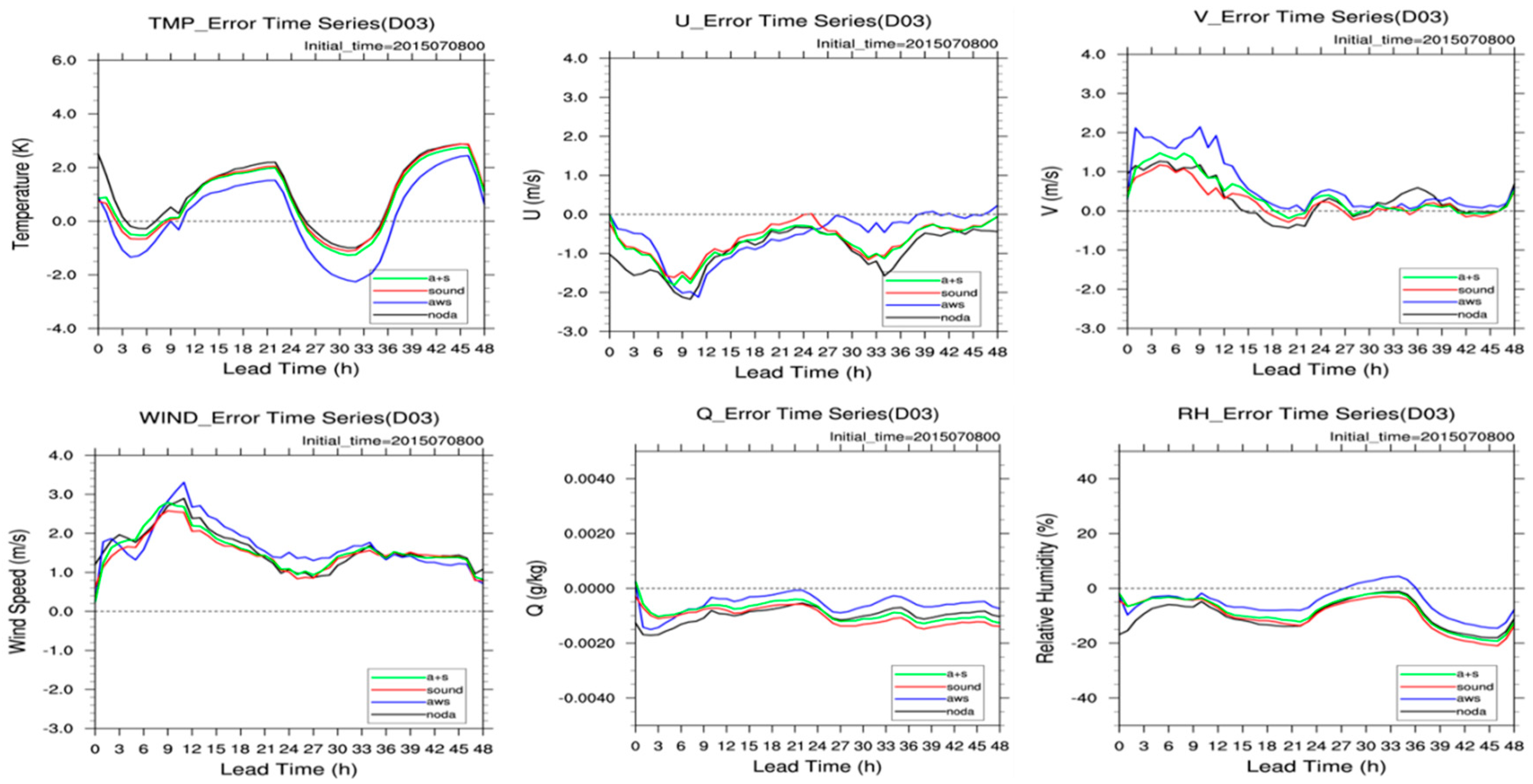

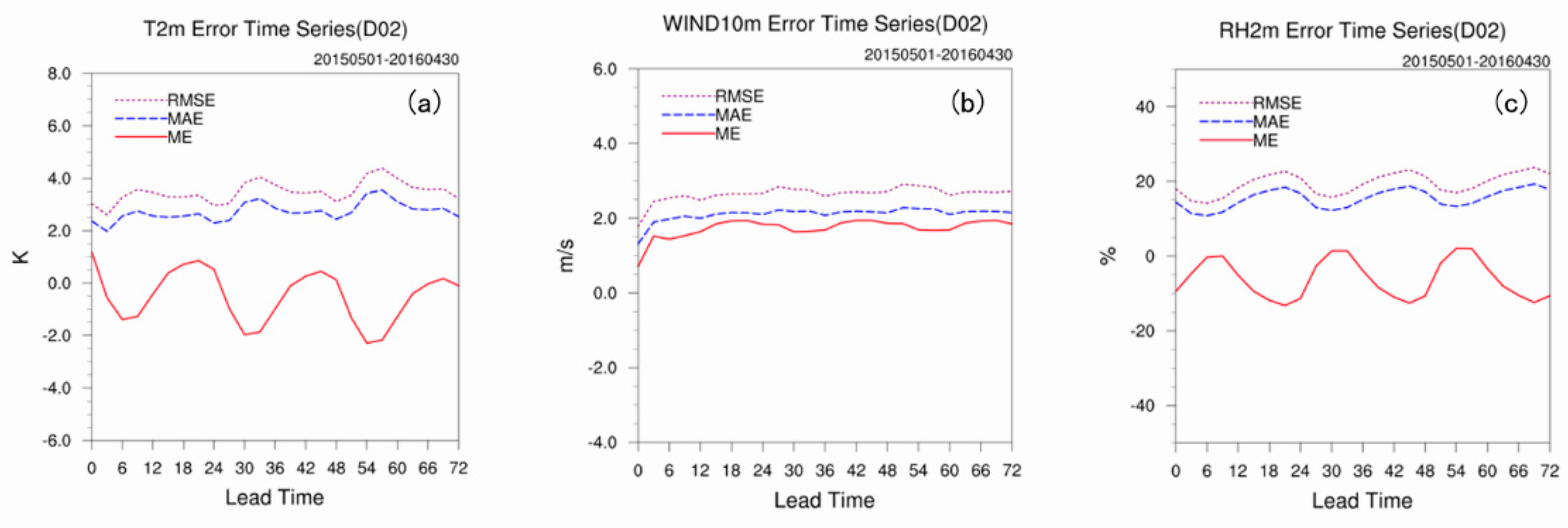
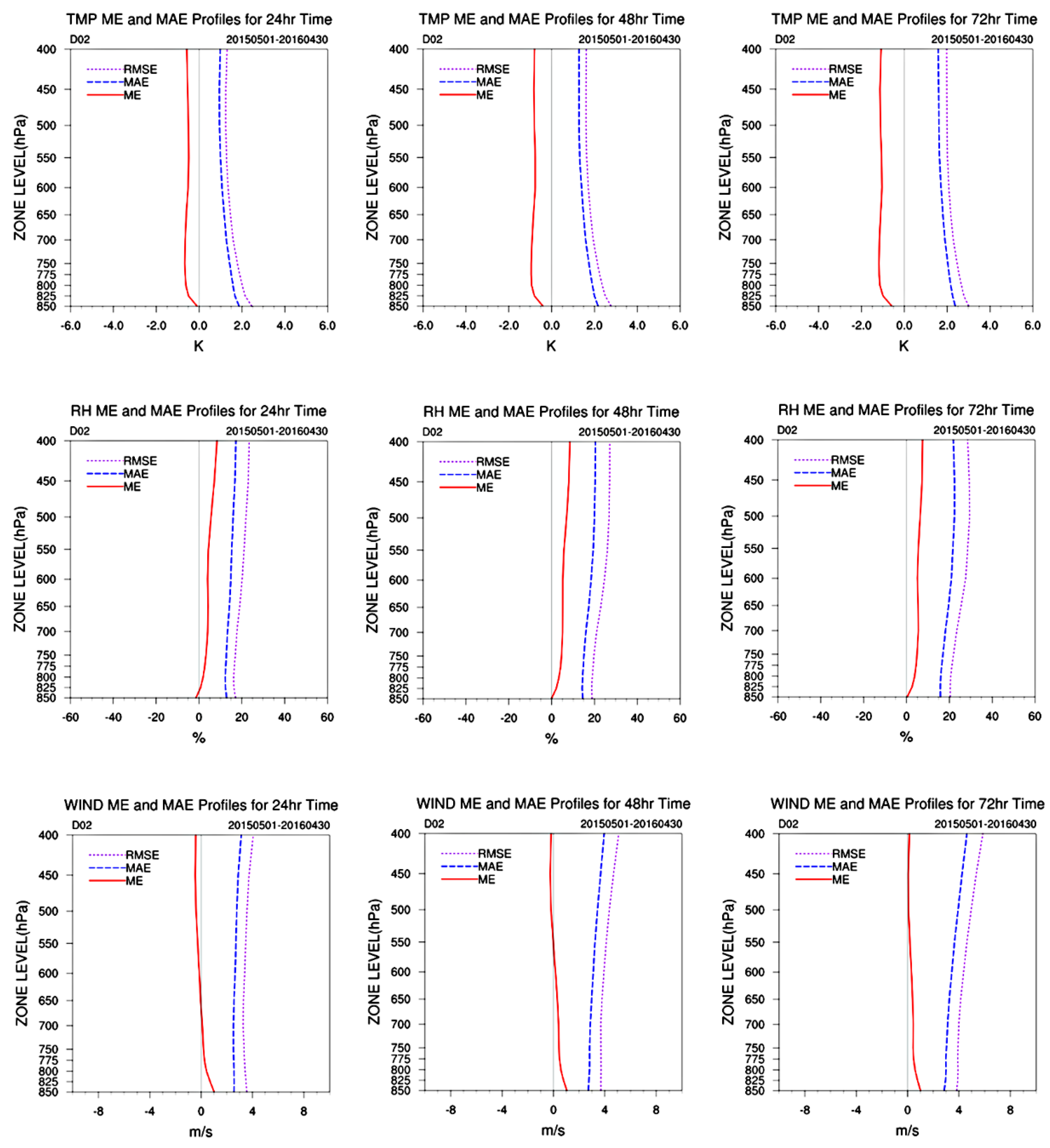

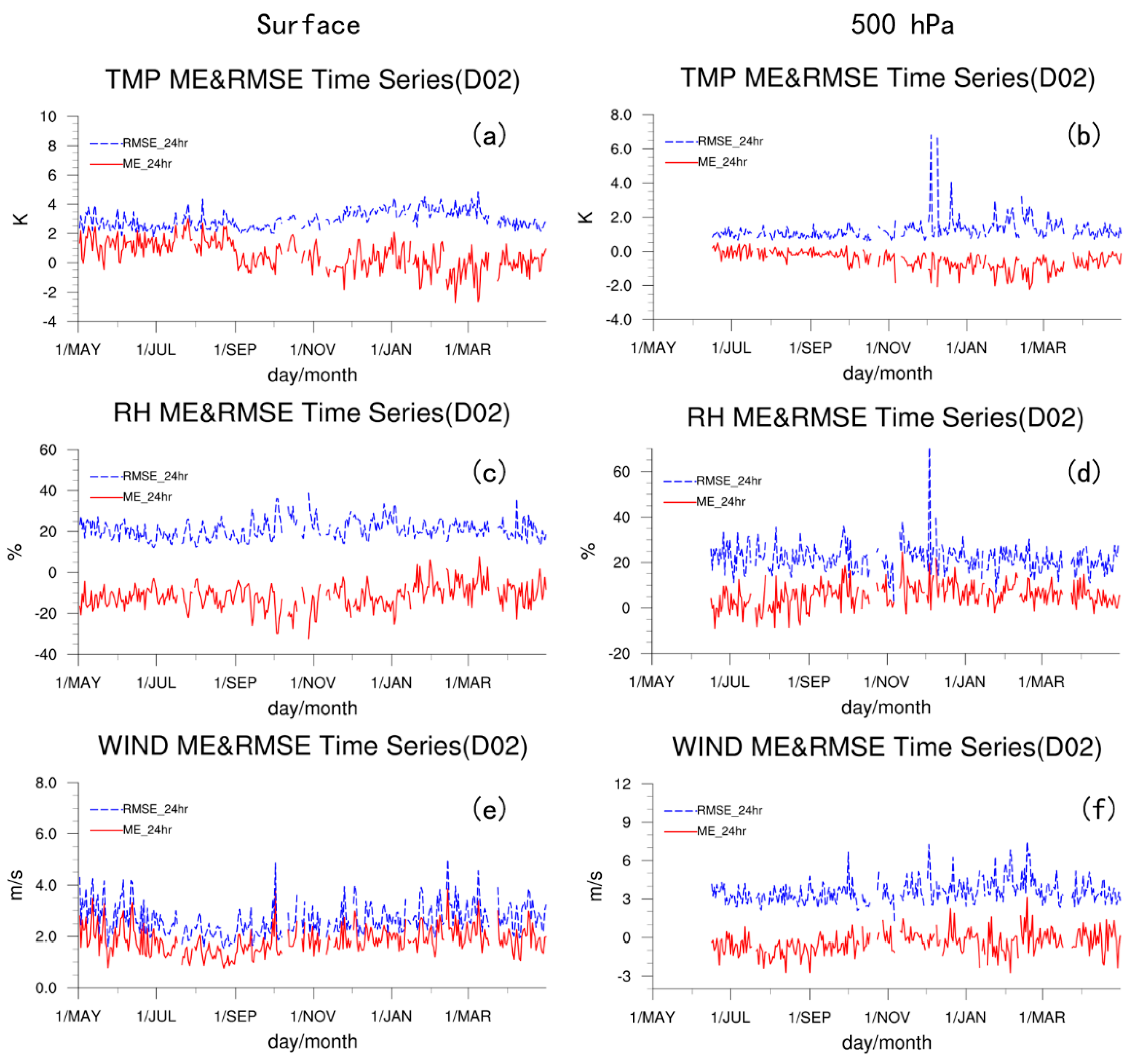
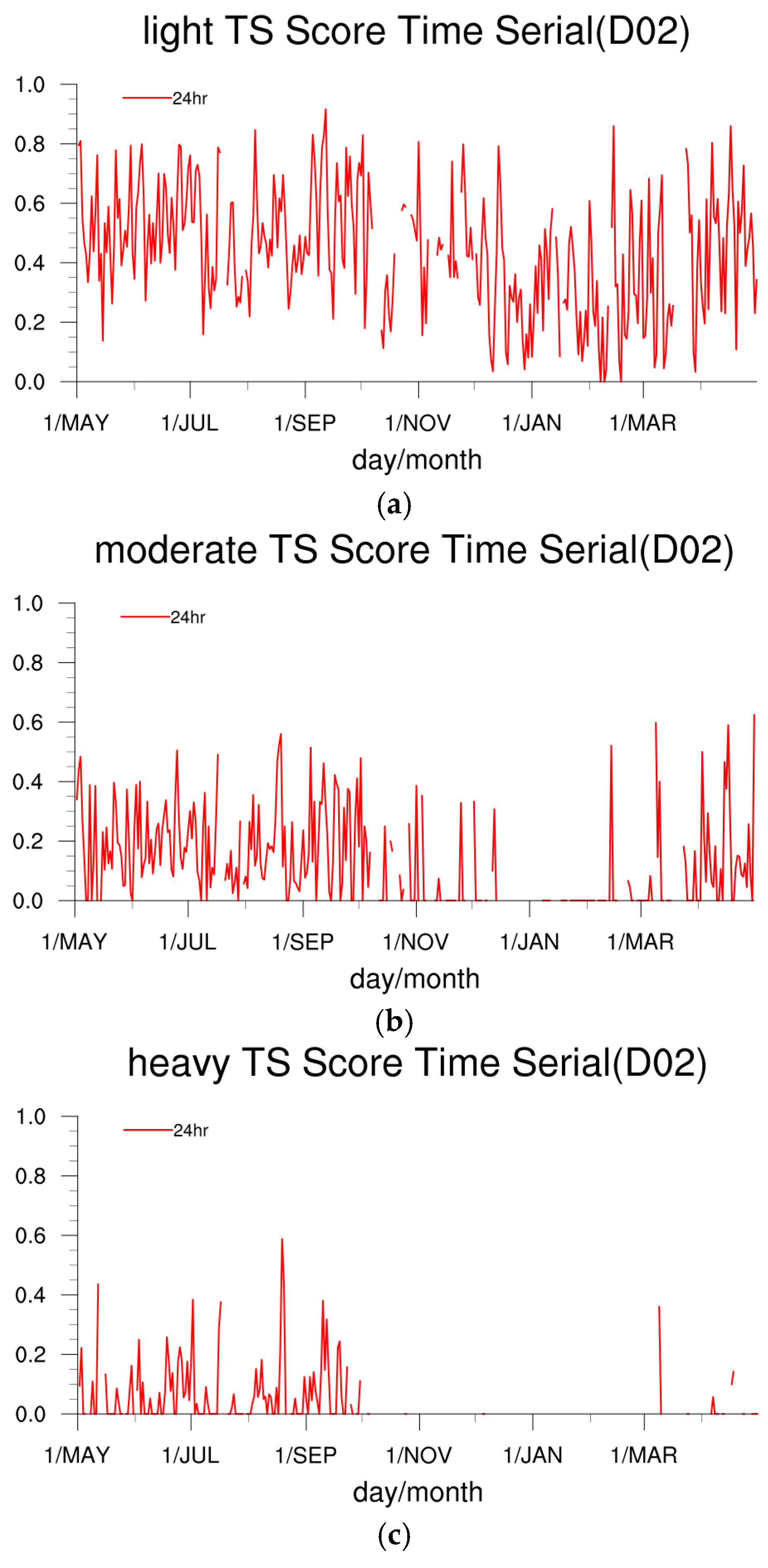
| Domain | Grid Numbers | Spatial Resolution (km) | Temporal Resolution (s) |
|---|---|---|---|
| D01 | 220 × 173 | 27 | 162 |
| D02 | 274 × 214 | 9 | 54 |
| D03 | 562 × 376 | 3 | 18 |
| Cumulus | Cumulus 3 km | Land Surface | Boundary Layer |
|---|---|---|---|
| Kain–Fritsch(KF) | NONE | NOAH | Asymmetric Convection Model 2 (ACM2) |
| Long wave radiation | Short wave radiation | Surface | Microphysical |
| RRTM | Dudhia | Monin–Obuklov | Thompson Graupel |
| Test | Test Period | Land-Use Data Used in the WRF Model |
|---|---|---|
| Control test | 1–31 July 2015/1–31 December 2015 | USGS |
| New land cover run | 1–31 July 2015/1–31 December 2015 | International Geosphere-Biosphere Programme (IGBP) |
| ME | MAE | ||||
|---|---|---|---|---|---|
| July 2015 | December 2015 | July 2015 | December 2015 | ||
| D01 | Control and observation | 0.61 * | −1.76 * | 2.41 * | 3.22 * |
| New land cover and observation | −0.12 | −1.18 * | 2.57 | 3.01 * | |
| D02 | Control and observation | 1.35 | −0.98 * | 2.61 | 2.91 * |
| New land cover and observation | 0.44 * | −0.32 | 2.49 * | 2.83 | |
| D03 | Control and observation | 1.54 * | −0.37 | 2.58 * | 2.66 |
| New land cover and observation | 1.76 * | 1.46 * | 2.72 * | 3.13 * | |
© 2019 by the authors. Licensee MDPI, Basel, Switzerland. This article is an open access article distributed under the terms and conditions of the Creative Commons Attribution (CC BY) license (http://creativecommons.org/licenses/by/4.0/).
Share and Cite
Zhang, T.; Li, Y.; Duan, H.; Liu, Y.; Zeng, D.; Zhao, C.; Gong, C.; Zhou, G.; Song, L.; Yan, P. Development and Evaluation of a WRF-Based Mesoscale Numerical Weather Prediction System in Northwestern China. Atmosphere 2019, 10, 344. https://doi.org/10.3390/atmos10060344
Zhang T, Li Y, Duan H, Liu Y, Zeng D, Zhao C, Gong C, Zhou G, Song L, Yan P. Development and Evaluation of a WRF-Based Mesoscale Numerical Weather Prediction System in Northwestern China. Atmosphere. 2019; 10(6):344. https://doi.org/10.3390/atmos10060344
Chicago/Turabian StyleZhang, Tiejun, Yaohui Li, Haixia Duan, Yuanpu Liu, Dingwen Zeng, Cailing Zhao, Chongshui Gong, Ganlin Zhou, Linlin Song, and Pengcheng Yan. 2019. "Development and Evaluation of a WRF-Based Mesoscale Numerical Weather Prediction System in Northwestern China" Atmosphere 10, no. 6: 344. https://doi.org/10.3390/atmos10060344
APA StyleZhang, T., Li, Y., Duan, H., Liu, Y., Zeng, D., Zhao, C., Gong, C., Zhou, G., Song, L., & Yan, P. (2019). Development and Evaluation of a WRF-Based Mesoscale Numerical Weather Prediction System in Northwestern China. Atmosphere, 10(6), 344. https://doi.org/10.3390/atmos10060344







